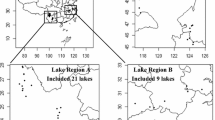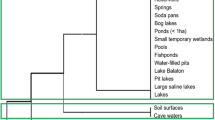Abstract
The functional group (FG) system sensu Colin S. Reynolds of freshwater phytoplankton has been widely applied in many aspects of freshwater ecological assessments. However, there is no current consensus as to how and to why some functional coda shows multiple habitat templates in different water bodies. To test whether there are multiple habitat templates for some functional coda in the FG system, we used two mesotrophic deep reservoirs in China as examples, analysing phytoplankton taxonomic and environmental data collected in 4 seasons over two years. Results showed that a large proportion of the indicators had similar habitat templates within the FG system, whilst some species had multiple or different habitat templates according to their niche differentiation. The random forest (RF) model filtered a minimum set of environmental conditions and provided two potential habitat templates for Oocystis lacustris. One explanatory habitat template of clear water provided by the FG system was verified in the Nanwan Reservoir, and the other habitat template of high dissolved inorganic nitrogen (DIN) was found in the Nianyushan Reservoir. Further studies of the potential multiple habitat templates for some functional coda are recommended for its proper use.







Similar content being viewed by others
Data availability
The data generated during the present study are available from the corresponding author on reasonable request.
Code availability
Not applicable.
References
Abonyi, A., J.-P. Descy, G. Borics & E. Smeti, 2021. From historical backgrounds towards the functional classification of river phytoplankton sensu Colin S. Reynolds: what future merits the approach may hold? Hydrobiologia 848: 131–142.
Association, A.P.H., Association, A.W.W., Federation, W.E., 2012. Standard Methods for the Examination of Water and Wastewater. 22th edition. In: Rice, E.W., Baird, R.B., Eaton, A.D., Clesceri, L.S. (eds). American Public Health Nations Health, Washington DC
Bohnenberger, J. E., L. R. Rodrigues, M. Da & L. O. Crossetti, 2018. Environmental dissimilarity over time in a large subtropical shallow lake is differently represented by phytoplankton functional approaches. Marine & Freshwater Research 69: 95–104.
Borcard, D., Gillet, F., Legendre, P., 2018. Numerical Ecology with R. In: Gentleman, R., Parmigiani, G.G., Hornik, K. (eds). Springer, Montréal.
Borics, G., G. Várbíró, I. Grigorszky, E. Krasznai, S. Szabó & K. T. Kiss, 2007. A new evaluation technique of potamo-plankton for the assessment of the ecological status of rivers. Large Rivers 161: 466–486.
Breiman, L., 1999. Random forests–random features. Machine Learning 45: 5–32.
Carlson, R. E., 1977. A trophic state index for lakes. Limnology and Oceanography 22: 361–369.
Cohen, J. E., J. Lai, D. A. Coomes & R. B. Allen, 2016. Taylor’s law and related allometric power laws in New Zealand mountain beech forests: the roles of space, time and environment. Oikos 125: 1342–1357.
De'Ath, G., 2006. The mvpart package. http://CRAN.R-project.org/package=mvpart.
Dufrene, M. & P. Legendre, 1997. Species assemblages and indicator species: the need for a flexible asymmetrical approach. Ecological Monographs 67: 345–366.
Dumont, H., I. Van de Velde & S. Dumont, 1975. The dry weight estimate of biomass in a selection of cladocera, copepoda and rotifera from the plankton, periphyton and benthos of continental waters. Oecologia 19: 75–97.
Fabbro, L. & L. Duivenvoorden, 2000. A two-part model linking multidimensional environmental gradients and seasonal succession of phytoplankton assemblages. Hydrobiologia 438: 13–24.
Guo, B., D. Zhang, L. Pei, Y. Su & L. Guo, 2021. Estimating PM25 concentrations via random forest method using satellite, auxiliary, and ground-level station dataset at multiple temporal scales across China in 2017. Science of the Total Environment 778: 146288.
Hillebrand, H., C. D. Durselen, D. Kirschel, U. Pollingher & T. Zohary, 1999. Biovolume calculation for pelagic and benthic microalgae. J. Phycol. 35: 403–424.
Hu, H. & Y. Wei, 2006. Chinese Freshwater Algae—System Classification and Ecology, Science Press, Beijing:
Hu, R., Y. Lan, L. Xiao & B. Han, 2015. The concepts, classification and application of freshwater phytoplankton functional groups. Journal of Lake Sciences 27: 11–23.
Hubbell, S. P., 2001. Unified Neutral Theory of Biodiversity & Biogeography, Princeton University Press, Princeton:
Jia, B., Simonovic, S., Zhong, P., Yu, Z., 2015. Improved Knowledge-based Cooperative Particle Swarm Optimization for Optimal Reservoir Flood Control Operation. CSCE 22nd Canadian Hydrotechnical Conference, Canada.
Junior, F., 2003. [R] Package cluster. https://cran.r-project.org/web/packages/cluster.
Kratzer, C. R. & P. L. Brezonik, 1981. A carlson-type trophic state index for nitrogen in Florida Lakes. Water Resources Bulletin 17: 713–715.
Kruk, C. & A. M. Segura, 2012. The habitat template of phytoplankton morphology-based functional groups. Hydrobiologia 698: 191–202.
Kruk, C., N. Mazzeo, G. Lacerot & C. S. Reynolds, 2002. Classification schemes for phytoplankton: a local validation of a functional approach to the analysis of species temporal replacement. Journal of Plankton Research 24: 901–912.
Lai, J., Y. Zou, J. Zhang & P. R. Peres-Neto, 2022. Generalizing hierarchical and variation partitioning in multiple regression and canonical analyses using the rdacca.hp R package. Methods in Ecology and Evolution 13: 782–788.
Le Quéré, C., S. P. Harrison, I. C. Prentice & E. T. Buitenhuis, 2010. Ecosystem dynamics based on plankton functional types for global ocean biogeochemistry models. Global Change Biology 11: 2016–2040.
Legendre, P. & E. D. Gallagher, 2001. Ecologically meaningful transformations for ordination of species data. Oecologia 129: 271–280.
Moreti, L. O. R., L. Martos, V. M. Bovo-Scomparin & L. C. Rodrigues, 2013. Spatial and temporal fluctuation of phytoplankton functional groups in a tropical reservoir. Acta Scientiarum Biological Sciences 35: 359–366.
Mutshinda, C. M., Z. V. Finkel, C. E. Widdicombe & A. J. Irwin, 2016. Ecological equivalence of species within phytoplankton functional groups. Functional Ecology 30: 1–9.
Okasen, J., Kindt, R., Legendre, P., O'Hara, R.B., 2007. Vegan: community ecology package version 1.8–6. https://cran.r-project.org/web/packages/vegan.
Padisák, J., F. A. R. Barbosa, R. Koschel & L. Krienitz, 2003. Deep layer cyanoprokaryota maxima in temperate and tropical lakes. Advances in Limnology 58: 175–199.
Padisák, J., G. Borics, I. Grigorszky & É. Soróczki-Pintér, 2006. Use of phytoplankton assemblages for monitoring ecological status of lakes within the water framework directive: the assemblage index. Hydrobiologia 553: 1–14.
Padisák, J., L. O. Crossetti & L. Naselli-Flores, 2009. Use and misuse in the application of the phytoplankton functional classification: a critical review with updates. Hydrobiologia 621: 1–19.
Peña, M. A., 2003. Plankton size classes, functional groups and ecosystem dynamics: an introduction. Progress in Oceanography 57: 239–242.
Reynolds, C. S., V. Huszar, C. Kruk, L. Naselli-Flores & M. Sergio, 2002. Towards a functional classification of the freshwater phytoplankton. Journal of Plankton Research 24: 417–428.
Roberts, D.W., 2006. labdsv: Laboratory for Dynamic Synthetic Vegephenomenology. http://CRAN.R-project.org/package=labdsv.
Rousseeuw, P., 1987. Silhouettes: a graphical aid to the interpretation and validation of cluster analysis. Journal of Computational & Applied Mathematics 20: 53–65.
Santana, L. M., L. O. Crossetti & C. Ferragut, 2017. Ecological status assessment of tropical reservoirs through the assemblage index of phytoplankton functional groups. Brazilian Journal of Botany 40: 695–704.
Seip, K. L. & C. S. Reynolds, 1995. Phytoplankton functional attributes along trophic gradient and season. Limnology and Oceanography 40: 589–597.
Vandecandelaere, M., 2012. [R] Package "glmulti": Include a variable in ALL models. http://CRAN.R-project.org/package=glmulti.
Wallhead, P. J., A. P. Martin, M. A. Srokosz & P. J. S. Franks, 2009. Skill assessment via cross-validation and Monte Carlo simulation: An application to Georges Bank plankton models. Journal of Marine Systems 76: 134–150.
Wickham, H., 2009. ggplot2: Elegant Graphics for Data Analysis. Springer, Houston. http://CRAN.R-project.org/package=ggplot2.
Wilke, C.O., 2017. ggridges: Ridgeline Plots in 'ggplot2'. http://CRAN.R-project.org/package=ggridges.
Zhang, M., R. A. Smyth, W. Zhu, L. Zhang, Y. Li, Y. Wang, X. Li, Q. Gu & Y. Gao, 2019a. Spatial distribution and filtering efficiency of Daphnia in a deep subtropical reservoir. Journal of Oceanology and Limnology 37: 1277–1288.
Zhang, M., Y. Wang, B. Gu, Y. Li, W. Zhu, L. Zhang, L. Yang & X. Li, 2019b. Resources utilization and trophic niche between silver carp and bighead carp in two mesotrophic deep reservoirs. Journal of Freshwater Ecology 34: 199–212.
Acknowledgements
We appreciate the help from all the colleagues at the administrations of the Nanwan and Nianyushan Reservoirs. They helped me to complete the field sampling work.
Funding
The work was funded by the earmarked fund for China Agriculture Research System (CARS-50), the National Natural Science Foundation of China (Grant Nos. U1904124, 31400397), and the Major Public Welfare Projects in Henan Province (Grant No. 201300311300).
Author information
Authors and Affiliations
Contributions
MZ: Conceptualization, Investigation, Writing—original draft, Funding acquisition. XL, JD, YG, JZ, XG and ML: Investigation, Resources, Validation. XL: Supervision, Project administration.
Corresponding author
Ethics declarations
Conflict of interest
The authors declare that they have no known competing financial interests or personal relationships that could have appeared to influence the work reported in this paper.
Ethical approval
Not applicable.
Consent to participate
All authors have given their consent to participate.
Consent for publication
All authors have given their consent to participate.
Additional information
Handling editor: Judit Padisák
Publisher's Note
Springer Nature remains neutral with regard to jurisdictional claims in published maps and institutional affiliations.
Rights and permissions
Springer Nature or its licensor holds exclusive rights to this article under a publishing agreement with the author(s) or other rightsholder(s); author self-archiving of the accepted manuscript version of this article is solely governed by the terms of such publishing agreement and applicable law.
About this article
Cite this article
Zhang, M., Lv, X., Dong, J. et al. Multiple habitat templates for phytoplankton indicators within the functional group system. Hydrobiologia 850, 5–19 (2023). https://doi.org/10.1007/s10750-022-05024-2
Received:
Revised:
Accepted:
Published:
Issue Date:
DOI: https://doi.org/10.1007/s10750-022-05024-2




